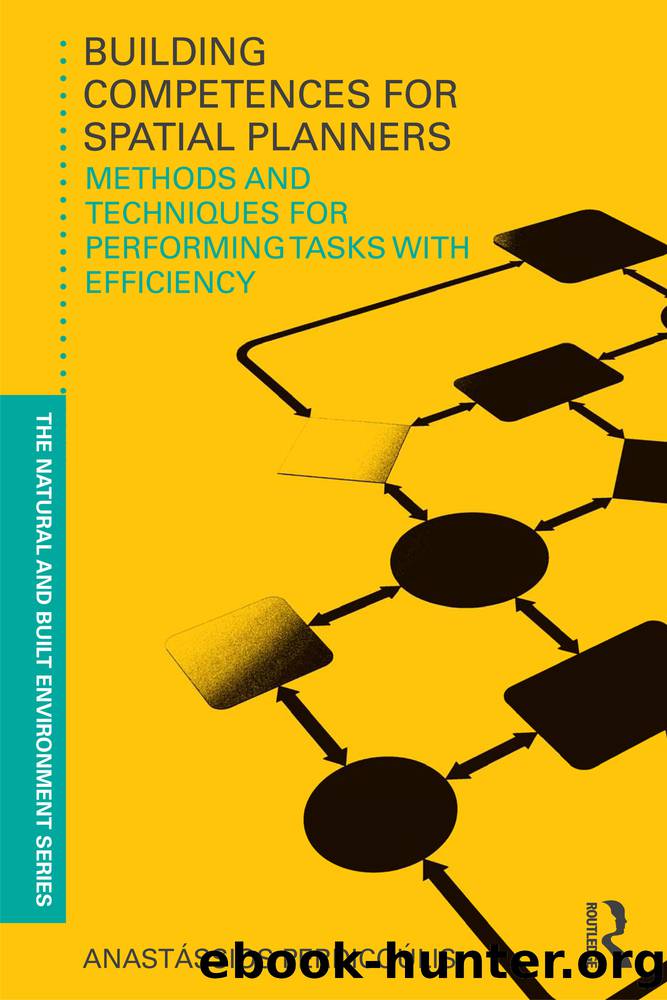Building Competences for Spatial Planners by Perdicoulis Anastassios;

Author:Perdicoulis, Anastassios; [Perdicoúlis, Anastássios]
Language: eng
Format: epub
Publisher: Taylor & Francis Group
Published: 2022-08-15T00:00:00+00:00
Technique 4.2.2 Expository writing
Expository writing is used in formal contexts, such as in scientific papers and technical reports. It produces text that does not require previous knowledge of the topic â a monograph. The structure of the document is important for the organisation of the information, and expository writing usually includes some basic ânavigationalâ directions either through descriptive section headings or within the text. The content usually follows clear references to time, space, and action â for instance, what happened or should happen first, how, and where. Finally, expository writing must remain objective, and should not reveal the opinion of the author. Due to these characteristics, expository writing is useful in the creation of planning instruments. Let us take an example regarding the presentation of intended outcomes (Example 4.2), extracted from a sustainable development strategy of a supra-national authority.
Example 4.2 The âenvironmental protection' objective (supra-national/global scale)
âSafeguard the earth's capacity to support life in all its diversity, respect the limits of the planet's natural resources and ensure a high level of protection and improvement of the quality of the environment. Prevent and reduce environmental pollution and promote sustainable consumption and production to break the link between economic growth and environmental degradation.â
Statements such as the one in Example 4.2 are quite common in planning instruments. While the intention is virtuous and the expression is formal, they frequently exhibit a semantic weakness â namely, that the choice of verbs could potentially cause a confusion between âwhat is a stateâ and âwhat is an actionâ â for instance, âto haveâ or âto doâ. The statement in Example 4.2 contains action verbs such as âsafeguardâ, ârespectâ, âpreventâ, âreduceâ, and âpromoteâ. Thus, although labelled as an âobjectiveâ, the statement describes what we should be doing rather than what we want to achieve or have. The confusion may arise for various reasons, but quite possibly from a degree of abstraction â namely,that objectives are about âwhat we wantâ. This âwantâ can be interpreted in two ways: either âwhat we want to haveâ, which is our intended outcome, or âwhat we want to doâ, which is our intended action.
At this stage of the planning process we are concerned with the intended outcomes, which are descriptions of (intended) states â for instance, ânon-polluted environmentâ or âpristine environmentâ. We should be reserving the action verbs for the next phase (Chapter 5), where we have to describe âwhat to doâ. The verbs to be safely used with the intended outcomes are, for instance, âto haveâ, âto achieveâ, or âto obtainâ.
Paying attention to the use of verbs or semantics may not seem very important in a planning situation with grave concerns such as unemployment, economic downturn, and environmental pollution, but we should not let the gravity of the situation lessen our rigour in the way we plan â that is, think and communicate. Though it may seem counter-intuitive, what is necessary in the case of difficult situations is an elevated level of rigour in the handling of information.
Download
This site does not store any files on its server. We only index and link to content provided by other sites. Please contact the content providers to delete copyright contents if any and email us, we'll remove relevant links or contents immediately.
Aircraft Design of WWII: A Sketchbook by Lockheed Aircraft Corporation(32187)
The Great Music City by Andrea Baker(31244)
Call Me by Your Name by André Aciman(20347)
The Secret History by Donna Tartt(18802)
The Art of Boudoir Photography: How to Create Stunning Photographs of Women by Christa Meola(18500)
Shoot Sexy by Ryan Armbrust(17633)
Plagued by Fire by Paul Hendrickson(17313)
Portrait Mastery in Black & White: Learn the Signature Style of a Legendary Photographer by Tim Kelly(16931)
Adobe Camera Raw For Digital Photographers Only by Rob Sheppard(16880)
Photographically Speaking: A Deeper Look at Creating Stronger Images (Eva Spring's Library) by David duChemin(16594)
Ready Player One by Cline Ernest(14486)
Pimp by Iceberg Slim(14303)
Bombshells: Glamour Girls of a Lifetime by Sullivan Steve(13949)
The Goal (Off-Campus #4) by Elle Kennedy(13448)
Art Nude Photography Explained: How to Photograph and Understand Great Art Nude Images by Simon Walden(12947)
Kathy Andrews Collection by Kathy Andrews(11705)
The Priory of the Orange Tree by Samantha Shannon(8839)
The remains of the day by Kazuo Ishiguro(8784)
Thirteen Reasons Why by Jay Asher(8762)
